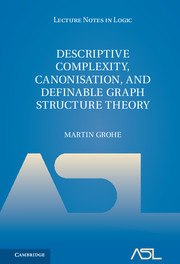Description
Descriptive Complexity, Canonisation, and Definable Graph Structure Theory
Lecture Notes in Logic Series
Author: Grohe Martin
This groundbreaking, yet accessible book explores the interaction between graph theory and computational complexity using methods from finite model theory.
Language: English
Subject for Descriptive Complexity, Canonisation, and Definable...:
Approximative price 174.56 €
In Print (Delivery period: 14 days).
Add to cart
Publication date: 08-2017
554 p. · 16x23.5 cm · Hardback
554 p. · 16x23.5 cm · Hardback
Description
/li>Contents
/li>Biography
/li>
Descriptive complexity theory establishes a connection between the computational complexity of algorithmic problems (the computational resources required to solve the problems) and their descriptive complexity (the language resources required to describe the problems). This groundbreaking book approaches descriptive complexity from the angle of modern structural graph theory, specifically graph minor theory. It develops a 'definable structure theory' concerned with the logical definability of graph theoretic concepts such as tree decompositions and embeddings. The first part starts with an introduction to the background, from logic, complexity, and graph theory, and develops the theory up to first applications in descriptive complexity theory and graph isomorphism testing. It may serve as the basis for a graduate-level course. The second part is more advanced and mainly devoted to the proof of a single, previously unpublished theorem: properties of graphs with excluded minors are decidable in polynomial time if, and only if, they are definable in fixed-point logic with counting.
1. Introduction; Part I. The Basic Theory: 2. Background from graph theory and logic; 3. Descriptive complexity; 4. Treelike decompositions; 5. Definable decompositions; 6. Graphs of bounded tree width; 7. Ordered treelike decompositions; 8. 3-Connected components; 9. Graphs embeddable in a surface; Part II. Definable Decompositions of Graphs with Excluded Minors: 10. Quasi-4-connected components; 11. K5-minor free graphs; 12. Completions of pre-decompositions; 13. Almost planar graphs; 14. Almost planar completions; 15. Almost embeddable graphs; 16. Decompositions of almost embeddable graphs; 17. Graphs with excluded minors; 18. Bits and pieces; Appendix. Robertson and Seymour's version of the local structure theorem; References; Symbol index; Index.
Martin Grohe is a Professor of Theoretical Computer Science at RTWH Aachen University, Germany, where he holds the Chair for Logic and the Theory of Discrete Systems. His research interests are in theoretical computer science interpreted broadly, including logic, algorithms and complexity, graph theory, and database theory.
© 2024 LAVOISIER S.A.S.
These books may interest you

Invariant Descriptive Set Theory 74.82 €

Recursion-Theoretic Hierarchies 174.56 €


